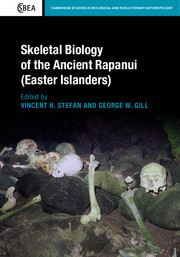Book contents
- Frontmatter
- Contents
- List of contributors
- Acknowledgements
- 1 Introduction: Research overview
- 2 Review of Polynesian and Pacific skeletal biology
- 3 Chronology and Easter Island prehistory
- 4 A descriptive skeletal biology analysis of the ancient Easter Island population
- 5 Craniometric variation of the prehistoric Polynesians and Rapanui
- 6 Rapanui non-metric cranial traits
- 7 Intra-island discrete cranial trait variation
- 8 Continuous non-metric characteristics of the early Rapanui
- 9 Rapanui dental morphology
- 10 Pelvic variability and sexual dimorphism in prehistoric Rapanui
- 11 Genetic affinities of the Rapanui
- 12 Archaeogenetics and paleodemographic estimation of founding populations: Features of residential geography on Rapa Nui
- 13 Evidence for injuries and violent death
- 14 Demographic analysis of modified crania from Rapa Nui
- 15 East Polynesian and Paleoindian parallels and contrasts in skeletal morphology
- 16 Rapanui origins, relationships, and warfare: A summary in theoretical context
- References
- Index
3 - Chronology and Easter Island prehistory
Published online by Cambridge University Press: 05 December 2015
- Frontmatter
- Contents
- List of contributors
- Acknowledgements
- 1 Introduction: Research overview
- 2 Review of Polynesian and Pacific skeletal biology
- 3 Chronology and Easter Island prehistory
- 4 A descriptive skeletal biology analysis of the ancient Easter Island population
- 5 Craniometric variation of the prehistoric Polynesians and Rapanui
- 6 Rapanui non-metric cranial traits
- 7 Intra-island discrete cranial trait variation
- 8 Continuous non-metric characteristics of the early Rapanui
- 9 Rapanui dental morphology
- 10 Pelvic variability and sexual dimorphism in prehistoric Rapanui
- 11 Genetic affinities of the Rapanui
- 12 Archaeogenetics and paleodemographic estimation of founding populations: Features of residential geography on Rapa Nui
- 13 Evidence for injuries and violent death
- 14 Demographic analysis of modified crania from Rapa Nui
- 15 East Polynesian and Paleoindian parallels and contrasts in skeletal morphology
- 16 Rapanui origins, relationships, and warfare: A summary in theoretical context
- References
- Index
Summary
Introduction
Building a reliable chronology forms a critical foundation to explaining prehistory, historical ecology, and human biology on Rapa Nui. A survey of the literature for Rapa Nui over the past few decades reveals a slowly changing picture of the island's chronology. Indeed, estimates of colonization and prehistoric events that followed have varied for hundreds of years, complicating greatly the research built on such shifting foundations. In 2006, we published an analysis of radiocarbon dates associated with the earliest known archaeological record of Rapa Nui (Hunt and Lipo, 2006). Based on a suite of new radiocarbon dates from our excavations of the Anakena Dune as well as a compilation of available published dates, we established a ranking of radiocarbon date reliability as indications of human behavior. From these results, we concluded that the island was colonized at some point soon after AD 1200. This significantly shorter chronology was not what we had originally expected. Indeed, this seemingly late date indicated that the island had a prehistoric chronology at least 400 – perhaps even 800 – years shorter than previously assumed. Given the island's famous stone statues and monumental architecture, a shortened chronology challenged many of the claims made about population growth rates, direct and indirect human impacts on the environment, and processes for the emergence of cultural elaboration such as statuary and monument construction. Additional research from multiple archipelagoes across East Polynesia now confirms late colonization, consistent with new dates as well as multiple lines of evidence from the Eastern Pacific (Hunt and Lipo, 2006; Rieth et al., 2011; Wilmshurst et al., 2011). Ultimately, there exists no reliable evidence in support of human occupation of Rapa Nui prior to AD 1200 – a pattern found for late and rapid settlement over a vast region of East Polynesia (Rieth et al., 2011; Wilmshurst et al., 2011).
A later chronology for Rapa Nui conforms to the growing body of evidence that humans colonized Eastern Polynesia relatively late in prehistory, as well as researchers demanding higher standards for reliable radiocarbon dating (Anderson, 2009; Arnold, 2007; Hunt and Lipo, 2008; Kennett et al., 2006a; Lie et al., 2007; Prebble and Dowe, 2008; Prebble and Wilmshurst, 2009; Rieth et al., 2011; Wells and Stock, 2007; Wilmshurst et al., 2008; Wilmshurst et al., 2011).
- Type
- Chapter
- Information
- Publisher: Cambridge University PressPrint publication year: 2016
- 3
- Cited by



